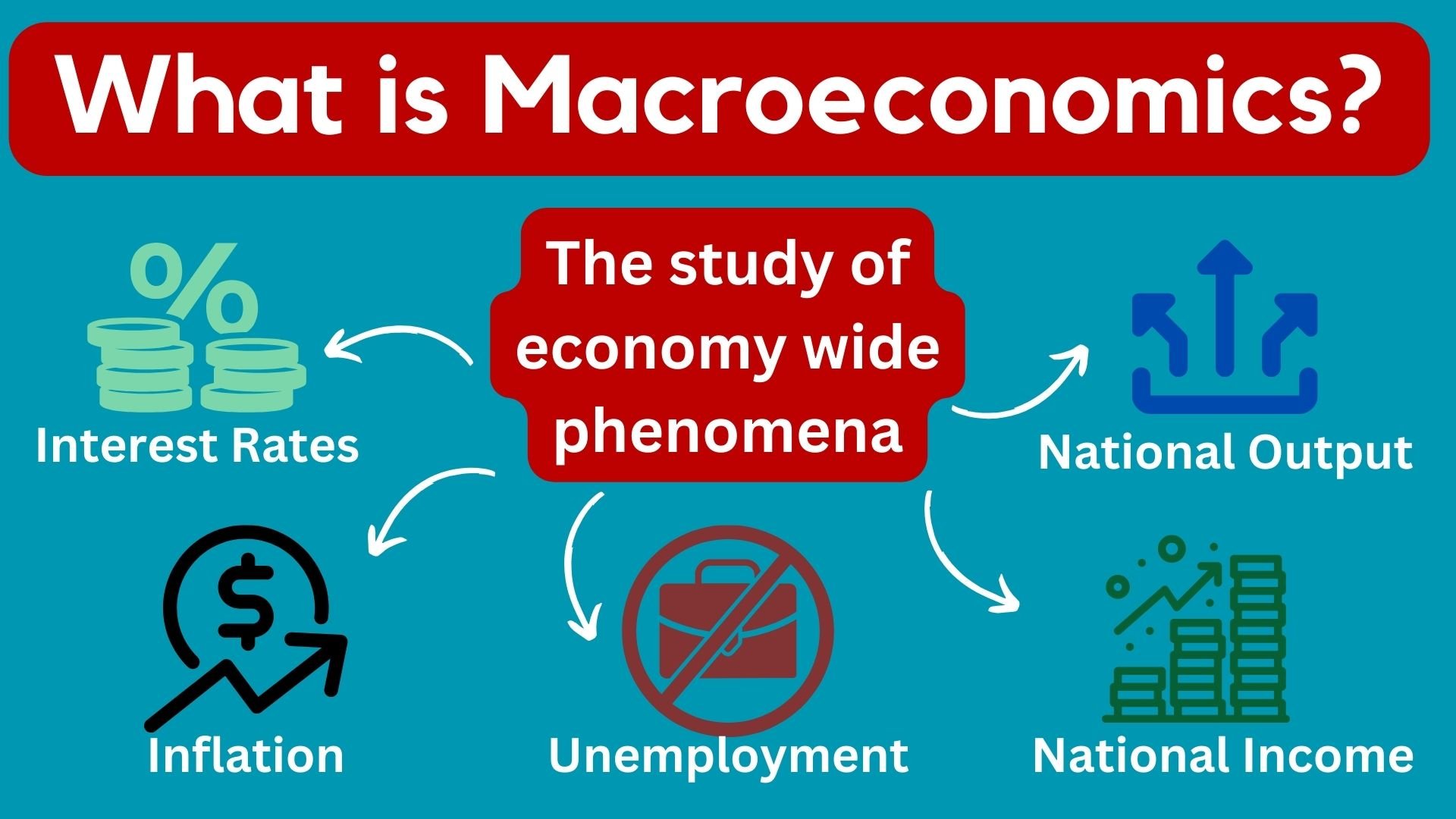Macroeconomics is a branch of economics that focuses on general or large-scale economic factors – it looks at the ‘big picture’. The word macro means overall or large-scale.
Macroeconomics gathers and analyzes economy-wide data and phenomena such as inflation, unemployment, GDP (gross domestic product) growth, and national income.
It studies how the aggregate (whole) economy behaves.
In its most basic form, macroeconomics deals with the performance, behavior, structure and decision-making of the aggregate economy, rather than focusing on individual markets.
Macroeconomics contrasts with Microeconomics, which is the study of the behavior of individual households, consumers, companies, workers, and markets.

Macroeconomics vs Microeconomics
Factors that are studied in both macroeconomics and microeconomics usually have an impact on one another. For example, the level of joblessness in the overall economy affects the availability of workers that a company can hire.
If you combine all microeconomic activity in the economy, you get the macroeconomic phenomena.
Macroeconomic policies have a profound influence on international trade and investment, shaping global economic landscapes.
Output and income
National output, or GDP, is everything a country produces in a specified period – either a month, a quarter, half a year, or 12 months.
Everything that is made and sold generates an equal amount of income. Output and income, therefore, are generally considered equivalent – the two terms are commonly used interchangeably.
Output may be measured as total income, or it can be observed from the production side and measured as the total value of finished products and services or the total sum of all value added (sum of the unit profit, the unit depreciation cost, and the unit labor cost) in the economy.
Macroeconomic output is typically measured by GDP or one of the other economy-wide accounts. Macroeconomists who are interested in long-term increases in output study GDP growth.
Over time, economic output increases because of the accumulation of machinery and other capital, advances in technology, better education, and human capital.
Unemployment
The unemployment rate is the percentage of people able to and wanting to work, but have no jobs. It does not include individuals who are retired, pursuing education, or those put off from seeking work due to poor prospects.
Inflation and deflation
Inflation is the rate at which the prices of products and services increase. It can be measured in a number of different ways. The most common and most frequently quoted ones are the RPI (retail prices index) and the CPI (consumer prices index).
The CPI and RPI each look at the prices of hundreds of products and services that consumers commonly spend money on, including beer, cinema tickets, bread, and milk – and track how these prices have fluctuated over time.
If the CPI is 3%, it means that on average, the price of goods and services is three percent higher than it was one year ago, i.e. we would need to spend three percent more to purchase the same things we bought one year ago.
Inflation is one of the most important issues in macroeconomics. It affects the interest rate people get on their savings and the rate borrowers pay on their mortgages.
It also has an effect on the level of pensions and state benefits, as well as the price of bus and train tickets.
Etymology of the prefixes “macro” and “micro”
Etymology is the study of the origin of words and how their meanings evolved over time.
The words “macro” and “micro” come from the Greek words “makros” and “mikros.”
“Makros” means “large” or “long”, while “mikros” means “small.”
Apart from words like macroeconomics and microeconomics, the prefixes “macro” and “micro” are widely used across various fields, such as biology (microorganisms), photography (macro lens), technology (microchip), chemistry (macromolecule), and medicine (microsurgery).
Macroeconomics – vocabulary and concepts
There are many terms in the English language specific to macroeconomics. Let’s have a look at some of them, understand their meanings, and see how they are used in a sentence:
-
Macroeconomic Stability
The absence of excessive fluctuations in the overall economy.
Example: “The central bank’s primary goal is to maintain macroeconomic stability through careful monetary policy.”
-
Macroeconomic Policy
Government actions designed to influence the performance of the economy as a whole.
Example: “Fiscal stimulus is a form of macroeconomic policy used to combat recessions.”
-
Macroeconomic Indicator
Statistics that indicate the current state of the economy.
Example: “Interest rates are a key macroeconomic indicator used to gauge economic health.”
-
Macroeconomic Forecasting
The process of making predictions about future economic performance.
Example: “Macroeconomic forecasting is essential for businesses to prepare for market changes.”
-
Macroeconomic Trend
The general direction in which the macroeconomy is moving.
Example: “The latest macroeconomic trend suggests a shift towards a digital economy.”
-
Macroeconomic Theory
A set of ideas explaining how the economy functions at a large scale.
Example: “Keynesian economics is a macroeconomic theory that emphasizes the role of government intervention in stabilizing the economy.”
Two Educational Videos
These two interesting video presentations, from our sister YouTube channel – Marketing Business Network, explain what ‘Macroeconomics’ and ‘Microeconomics’ are using simple, straightforward, and easy-to-understand language and examples.
-
What is Macroeconomics?
-
What is Microeconomics?
